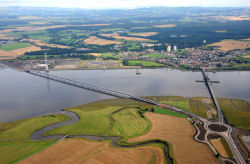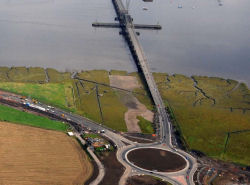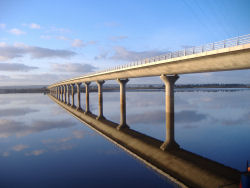A876 Upper Forth Crossing at Kincardine (Clackmannanshire Bridge) |
|
Whole Project Award
Project Team:
Client:
Transport
Scotland
Design Checking: Jacobs
Engineering, Benaim (part of Scott Wilson) and Gifford
Design:
WA
Fairhurst & Partners,
Construction:
Morgan
Vinci
 |
|
|
The project
The Upper Forth Crossing at Kincardine (Clackmannanshire Bridge) has brought substantial benefits to Kincardine and the surrounding area. It provides a safer, cleaner and quieter environment with traffic being dramatically reduced through the village of Kincardine, while the sensitive ecology of the Firth of Forth has been protected.
The scheme consists of the following elements:
- 6.4km of mainline roads including a 1.2km multi-span crossing of the Forth (the Clackmannanshire Bridge)
- 3.1 km of side roads
- 5km of cycle/footways
- 4 other major bridges
- Grade-separated junction, and 2 major roundabouts
- Extensive environmental mitigation, including a managed coastal realignment at Kennet Pans.
Prior to the opening of the Clackmannanshire Bridge, the existing Kincardine Bridge had become heavily congested, leading to long delays for the travelling public. High traffic volumes were also causing community severance, noise and air pollution problems for residents of Kincardine village.
 |
|
|
Construction
Construction of the new crossing and approach roads was completed on time and to budget in November 2008.
Weighing 35,000t and 1.2km in length, the bridge was launched from the north side of the estuary, making it the second longest continuous deck launch in the world.
This incremental launch method of construction minimised disruption to the more environmentally sensitive south bank, and also provided a safe, factory area for construction of the main deck on site.
The bridge
At the conceptual design stage, Transport Scotland and Jacobs developed a ‘twin bridge’ strategy which would allow the historically important existing bridge to be refurbished and retained to operate in conjunction with a new crossing upstream.
This solution optimised the use of existing infrastructure to provide an economically efficient solution which more than doubled the traffic capacity across the estuary. In order to minimise visual and environmental impacts, a low-level, multi-span design was developed with 26 spans, typically 45m length.
 |
|
|
Ecology
The new bridge had to cross environmentally sensitive areas of saltmarsh and mudflat, which extend over almost the full length of the Firth of Forth. This habitat is protected under European law and international conventions due to its importance for migratory and wintering birds.
Successful completion of the project demanded a minimum impact on this habitat. Extensive environmental mitigation measures were therefore integrated into the design and construction process.
New cycle routes
In addition to the new crossing, the scheme also required construction of 5.2km of approach roads linking the bridge to the existing trunk road network.
Extensive cycle tracks were built parallel to these approach roads, providing a new link across the Forth Estuary for the National Cycle Network and also providing other routes for local cyclists, which made use of local roads and new bridges to avoid trunk road traffic.

